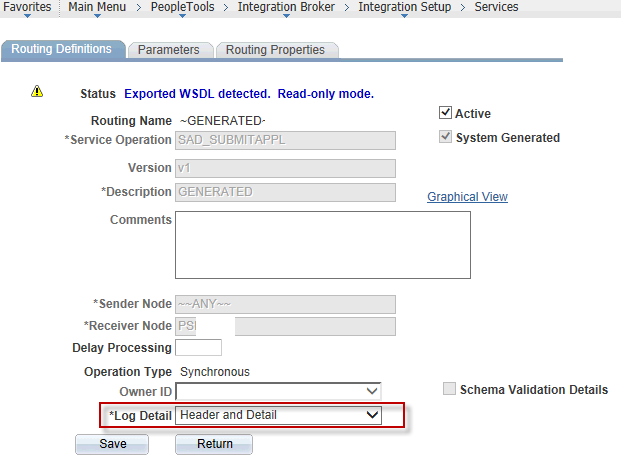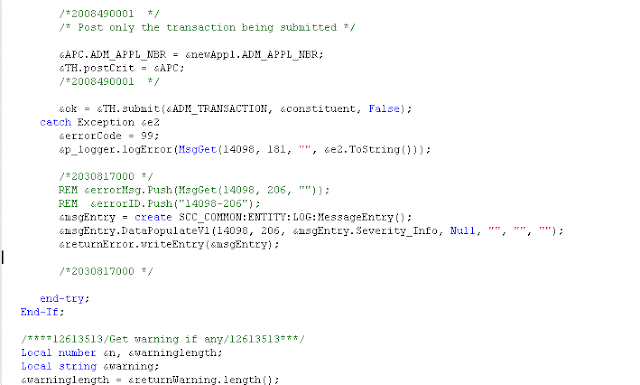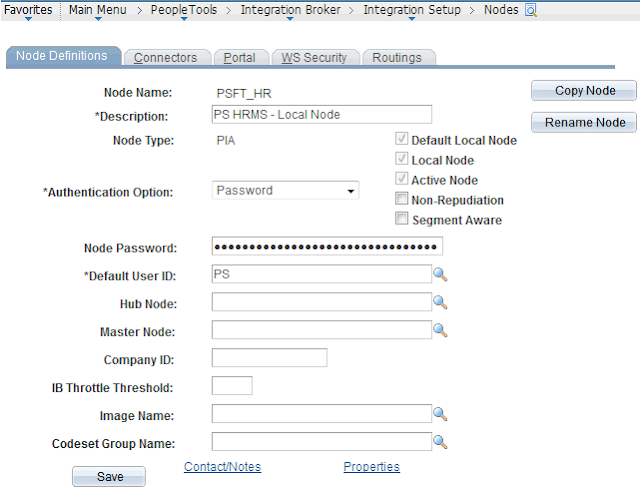This is a follow up to my previous post where we discussed how to use Apache Commons HttpClient for REST in PeopleSoft. Here are some more examples.
GetMethod - Adding Cookie (Header) to the Request:
Local JavaObject &jHttp, jMethod;
/* Initialize HttpClient and set parameters */
&jHttp = CreateJavaObject("org.apache.commons.httpclient.HttpClient");
&jHttp.getHttpConnectionManager().getParams().setConnectionTimeout(20000);
/* Initialize PostMethod and Set Request Details */
Local string &sURL = "https://cas.test.com/cas/v1/tickets";
&jMethod = CreateJavaObject("org.apache.commons.httpclient.methods.PostMethod", &sURL);
&jMethod.setFollowRedirects( False);
&jMethod.setRequestHeader("Content-Type", "text/plain");
&jMethod.setRequestBody("username=testuser&password=testpassword");
/* Invoke PostMethod */
&jHttp.executeMethod(&jMethod);
Local integer &responseStatus = &jMethod.getStatusLine().getStatusCode();
Local string &responseBody = &jMethod.getResponseBodyAsString();
MessageBox(0, "", 0, 0, "&responseBody " | &responseBody);
MessageBox(0, "", 0, 0, "&responseStatus " | &responseStatus);
&jMethod.releaseConnection();
GetMethod - Adding Cookie (Header) to the Request:
Local JavaObject &jHttp, &jMethod;
/* Initialize HttpClient and set parameters */
&jHttp = CreateJavaObject("org.apache.commons.httpclient.HttpClient");
&jHttp.getHttpConnectionManager().getParams().setConnectionTimeout(20000);
&jHttp.getHttpConnectionManager().getParams().setConnectionTimeout(20000);
/* Initialize GetMethod */
&sURL = "https://www.test.com/name.v1/get?emplid=12345";
&sURL = "https://www.test.com/name.v1/get?emplid=12345";
&jMethod = CreateJavaObject("org.apache.commons.httpclient.methods.GetMethod", &sURL);
&jMethod.setFollowRedirects( False);
&jMethod.setFollowRedirects( False);
/* Adding Cookie to the Request */
&jMethod.setRequestHeader("Cookie", "JSESSIONID=64497D7D587637EBF17E128881C04016";
/* Adding Cookie to the Request */
/* Adding Cookie to the Request */
/* Invoke GetMethod */
&return = &jHttp.executeMethod(&jMethod);
&responseStatus = &jMethod.getStatusLine().getStatusCode();
&return = &jHttp.executeMethod(&jMethod);
&responseStatus = &jMethod.getStatusLine().getStatusCode();
MessageBox(0, "", 0, 0, "Response Status: " | &responseStatus);
MessageBox(0, "", 0, 0, "Response Message: " | &jMethod.getResponseBodyAsString());
&jMethod.releaseConnection();
PostMethod - Plain Text Content:
Local JavaObject &jHttp, jMethod;
/* Initialize HttpClient and set parameters */
&jHttp = CreateJavaObject("org.apache.commons.httpclient.HttpClient");
&jHttp.getHttpConnectionManager().getParams().setConnectionTimeout(20000);
/* Initialize PostMethod and Set Request Details */
Local string &sURL = "https://cas.test.com/cas/v1/tickets";
&jMethod = CreateJavaObject("org.apache.commons.httpclient.methods.PostMethod", &sURL);
&jMethod.setFollowRedirects( False);
&jMethod.setRequestHeader("Content-Type", "text/plain");
&jMethod.setRequestBody("username=testuser&password=testpassword");
/* Invoke PostMethod */
&jHttp.executeMethod(&jMethod);
Local integer &responseStatus = &jMethod.getStatusLine().getStatusCode();
Local string &responseBody = &jMethod.getResponseBodyAsString();
MessageBox(0, "", 0, 0, "&responseBody " | &responseBody);
MessageBox(0, "", 0, 0, "&responseStatus " | &responseStatus);
&jMethod.releaseConnection();
PostMethod - Multi-Part Message:
In this example, we will be posting a file on the App Server file system as a multi-part message.
Local JavaObject &jHttp, &jMethod, &filePart, &partArray, &mPartReqEntity;
/* Initialize HttpClient and set parameters */
In this example, we will be posting a file on the App Server file system as a multi-part message.
Local JavaObject &jHttp, &jMethod, &filePart, &partArray, &mPartReqEntity;
/* Initialize HttpClient and set parameters */
&jHttp = CreateJavaObject("org.apache.commons.httpclient.HttpClient");
&jHttp.getHttpConnectionManager().getParams().setConnectionTimeout(20000);
/* Initialize PostMethod */
/* Initialize PostMethod */
Local string &sURL = "https://doc.mgmt.com/upload/v1/filename=test.pdf";
&jMethod = CreateJavaObject("org.apache.commons.httpclient.methods.PostMethod", &sURL);
&jMethod.setFollowRedirects( False);
/* Add Multi-Part Message */
/* Create File Object from App Server */
Local JavaObject &file = CreateJavaObject("java.io.File", "/tmp/test.pdf");
/* Create File Part */
/* Add Multi-Part Message */
/* Create File Object from App Server */
Local JavaObject &file = CreateJavaObject("java.io.File", "/tmp/test.pdf");
/* Create File Part */
&filePart = CreateJavaObject("org.apache.commons.httpclient.methods.multipart.FilePart", "test.pdf", &file);
/* Add File Part to Part Array */
&partArray = CreateJavaObject("org.apache.commons.httpclient.methods.multipart.Part[]", &filePart);
/* Create Multi-Part Request Entity */
&mPartReqEntity = CreateJavaObject("org.apache.commons.httpclient.methods.multipart.MultipartRequestEntity", &partArray, &jMethod.getParams());
/* Add Multi-Part Request Entity to the Post Method */
&jMethod.setRequestEntity(&mPartReqEntity);
/* Add Multi-Part Message */
/* Invoke PostMethod */
Local integer &return = &jHttp.executeMethod(&jMethod);
Local integer &responseStatus = &jMethod.getStatusLine().getStatusCode();
&jMethod.releaseConnection();
DeleteMethod:
/* Initialize DeleteMethod */
/* Add File Part to Part Array */
&partArray = CreateJavaObject("org.apache.commons.httpclient.methods.multipart.Part[]", &filePart);
/* Create Multi-Part Request Entity */
&mPartReqEntity = CreateJavaObject("org.apache.commons.httpclient.methods.multipart.MultipartRequestEntity", &partArray, &jMethod.getParams());
/* Add Multi-Part Request Entity to the Post Method */
&jMethod.setRequestEntity(&mPartReqEntity);
/* Add Multi-Part Message */
/* Invoke PostMethod */
Local integer &return = &jHttp.executeMethod(&jMethod);
Local integer &responseStatus = &jMethod.getStatusLine().getStatusCode();
Local string &responseBody = &jMethod.getResponseBodyAsString();
MessageBox(0, "", 0, 0, "&responseBody " | &responseBody);
MessageBox(0, "", 0, 0, "&responseStatus " | &responseStatus);
&jMethod.releaseConnection();
DeleteMethod:
Local JavaObject &jHttp, jMethod;
/* Initialize HttpClient and set parameters */
/* Initialize HttpClient and set parameters */
&jHttp = CreateJavaObject("org.apache.commons.httpclient.HttpClient");
&jHttp.getHttpConnectionManager().getParams().setConnectionTimeout(20000);
/* Initialize DeleteMethod */
Local string &sURL = "https://doc.mgmt.com/delete/v1/filename=test.pdf";
Local JavaObject &jMethod = CreateJavaObject("org.apache.commons.httpclient.methods.DeleteMethod", &sURL);
&jMethod.setFollowRedirects( False);
/* Invoke DeleteMethod */
Local integer &return = &jHttp.executeMethod(&jMethod);
Local integer &responseStatus = &jMethod.getStatusLine().getStatusCode();
&jMethod.releaseConnection();
/* Invoke DeleteMethod */
Local integer &return = &jHttp.executeMethod(&jMethod);
Local integer &responseStatus = &jMethod.getStatusLine().getStatusCode();
Local string &responseBody = &jMethod.getResponseBodyAsString();
MessageBox(0, "", 0, 0, "&responseBody " | &responseBody);
MessageBox(0, "", 0, 0, "&responseStatus " | &responseStatus);
&jMethod.releaseConnection();






